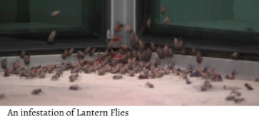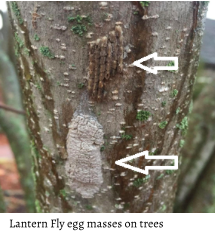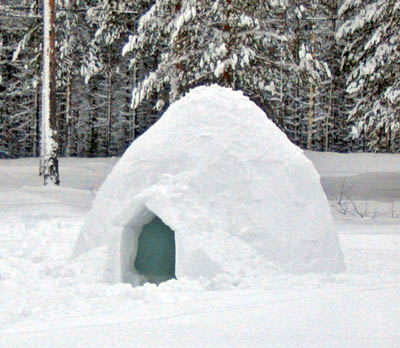
During the past couple of months, you may have noticed the mysterious arrival of the spotted lantern fly. They have been seen all over states such as New Jersey, New York, and Pennsylvania. Even on our Friends Academy campus, you may have spotted a couple of these insects. This article will tell you everything you need to know about spotted lantern flies, their arrival, and their impact on our environment.
The Lycorma Delicatula, known more commonly as the Spotted Lanternfly, first appeared in Pennsylvania in 2014 when a shipment of stone also carried the insect’s eggs into the US. According to NBC News, these insects are an invasive species originating from Asia.  Their spread is mainly attributed to human movements because the insects lay their eggs on vehicles that transport materials to new places. The widespread use of transportation vehicles ultimately allowed the insects to spread throughout the northeast regions of the country.
Their spread is mainly attributed to human movements because the insects lay their eggs on vehicles that transport materials to new places. The widespread use of transportation vehicles ultimately allowed the insects to spread throughout the northeast regions of the country.
The extensive spread of these insects is particularly concerning due to the detrimental effects that they have on the environment. According to ABC News, “the invasive species can cause significant damage to wooded areas and agriculture like fruit trees. The biggest concern is about the grape and wine industry, mostly on Long Island . . . it could cost the New York economy $300 million a year.” The New York State Department of Environmental Conservation explains that, “the lantern flies feed on the sap of a wide variety of plant species. Because of this excessive feeding, by at times thousands of lantern flies, plants become weak and therefore vulnerable to disease and attacks from other insects.” Therefore, it is crucial for us to respond to this issue and help in any way that we can.

There are many things that you can do as an individual to help mitigate this problem, as easy as inspecting your trees for egg masses. With winter coming up, you can check the items you buy before bringing them inside to prevent the transportation of insects to your house. According to the USDA, if you do find any egg masses, you can easily remove them by scraping them into a plastic bag with hand sanitizer inside; this will kill the eggs. In addition to egg masses, you can also identify the presence of lantern flies by their honeydew, a liquid excretion that accumulates at the base of trees after rainfall. Lastly, you can learn how to report sightings on “Where’s the Threat and How to Report.” You may not think your contributions are consequential in the prevention effort, but even simple steps, as previously mentioned, are vital to combating the spread of lantern flies.








Ms. H • Dec 11, 2023 at 2:43 pm
Thank you for this informative article!